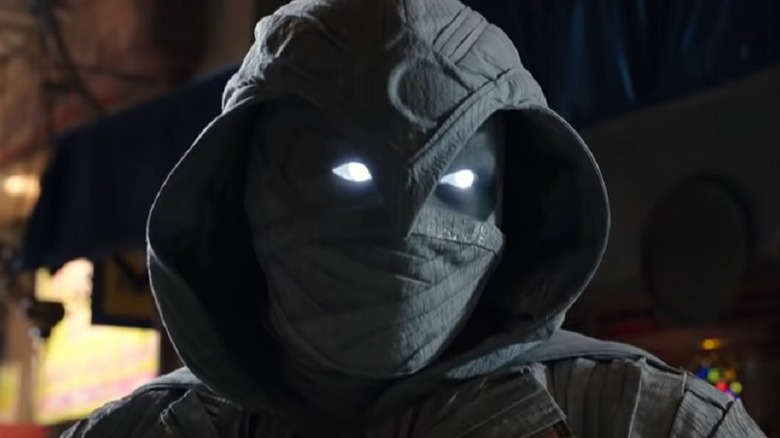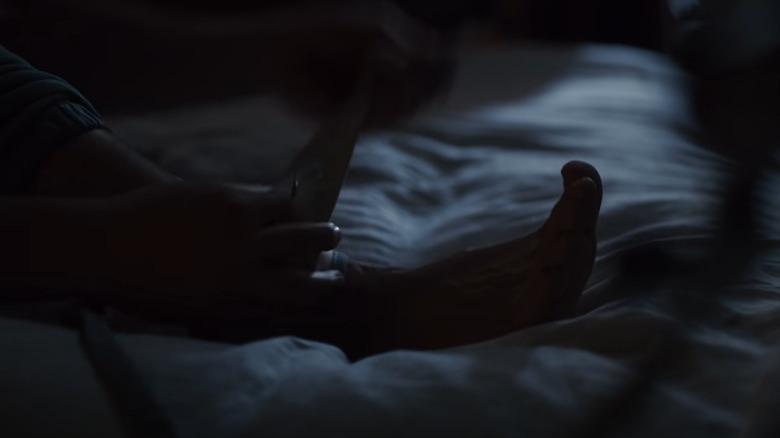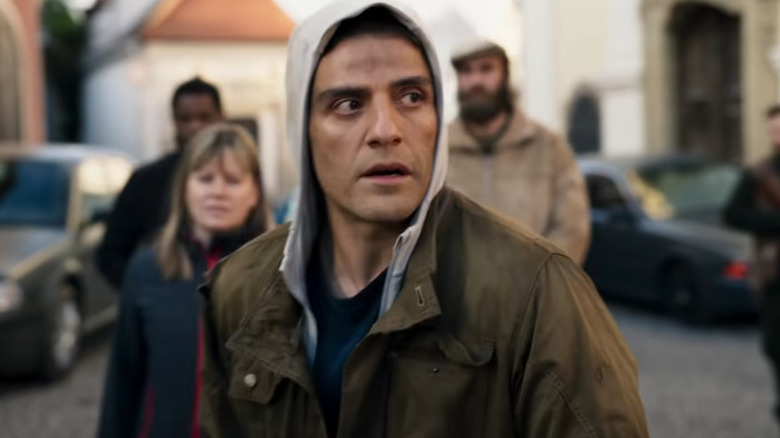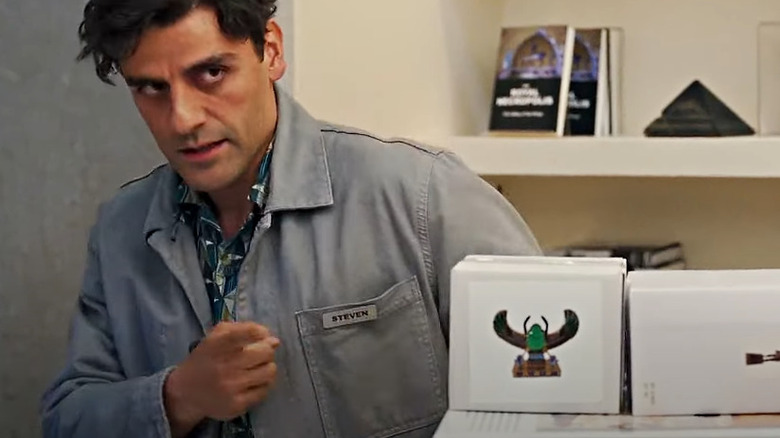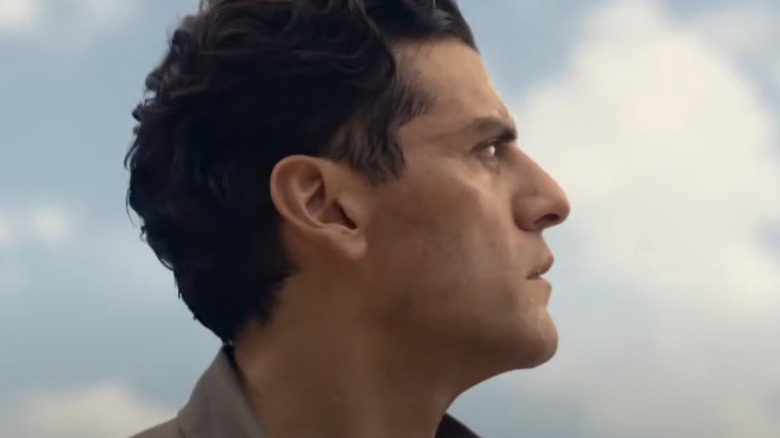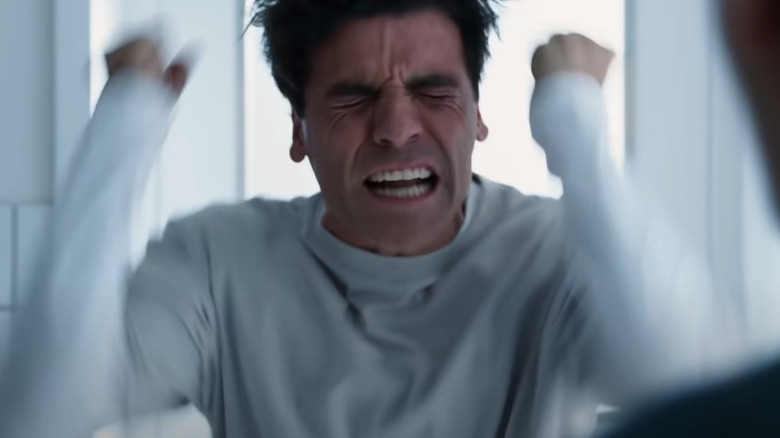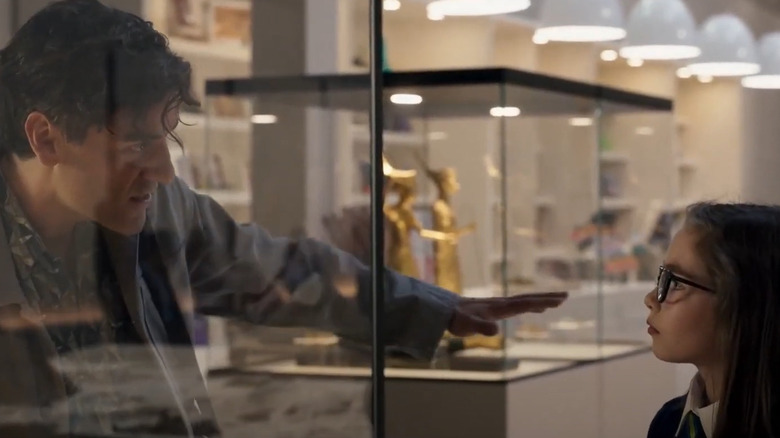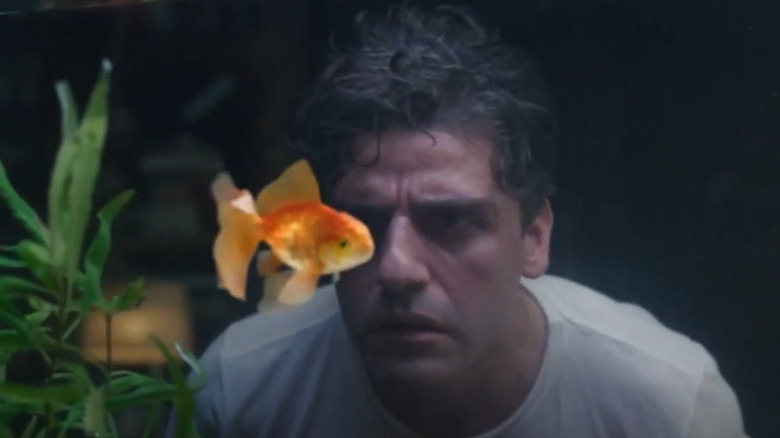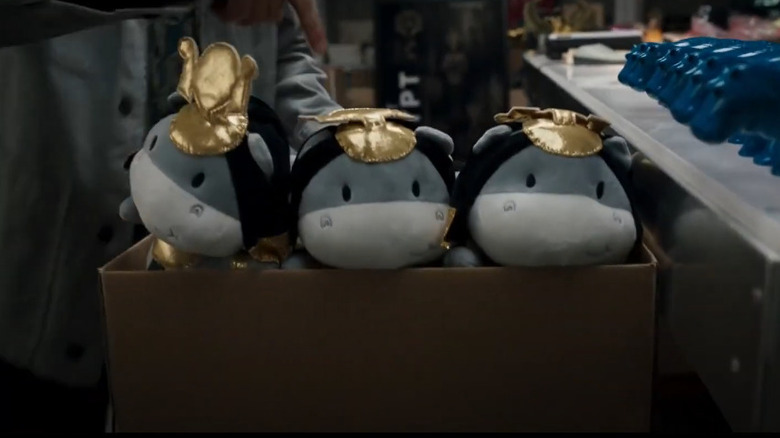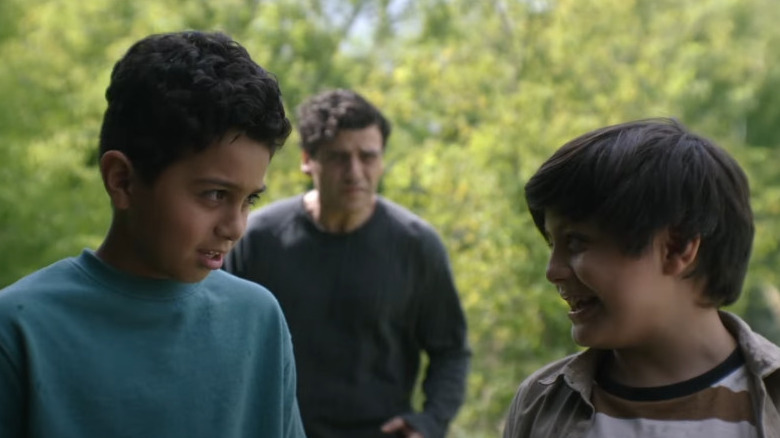Scenes In Moon Knight That Mean More Than You Think
On the whole, "Moon Knight," which features the titular character's debut in the Marvel Cinematic Universe, was received positively by fans and reviewers alike. "Marvel's newest addition shoots for the moon and largely hits its mark," as Empire deftly put it, and this is because "the central character's humanity [is] on a level with his heroics." Meanwhile, TechRadar praised the addition of "Moon Knight" to the MCU, calling it "superbly surreal, subversive, and supernatural-fuelled."
Part of what makes "Moon Knight" so compelling are the skillful parallels and subtle clues peppered throughout the show. These moments place it above standard superhero fare and turn it into an ongoing mystery of sorts. Most of these clever hints revolve around Marc Spector/Steven Grant (Oscar Isaac) and why Khonshu (F. Murray Abraham) chose him as his earthly avatar.
Here are some of the scenes in "Moon Knight" that either offered early clues about the character or hinted at what may be in store for his future. Spoilers ahead.
The feet parallels
The opening sequence of "Moon Knight" gives viewers a glimpse at the daily lives of the show's yin and yang: Arthur Harrow (Ethan Hawke) and Steven Grant. The first episode begins with Harrow dropping glass shards into his footwear — the implication is that Harrow walks around all day in the shard-embedded slippers. The next scene shows Steven waking up and checking if he's still in his house. He then removes the strap around his ankle, which he uses to tie himself to his bed (the gift shop worker is unaware of his dual life at this point, and merely thinks he sleepwalks). Aside from being a clever use of related yet contrasting imagery, these scenes offer a deeper look at the two characters' mental states.
Both Harrow's and Steven's peculiar rituals at the beginning of their respective days involve their feet. However, Harrow's habit seems to come from either self-assurance or self-punishment. On one hand, he knows exactly what he wants to accomplish — he wishes to resurrect Ammit so that the Egyptian goddess can deliver her brand of preemptive justice once more — and keeps himself in constant discomfort to stay focused. It may also be his silent act of repentance for all the horrible acts he commits along the way. Meanwhile, Steven's behavior stems from a place of uncertainty. He is unsure what happens while he sleeps and thus resorts to drastic measures to stay out of harm.
Waking up in a white hoodie
Steven's first major misadventure — and his first glimpse at his unknown life as Khonshu's servant — happens in Episode 1, when he wakes up in a field with a dislocated jaw and armed guards trying to shoot him. This is also when he has his first conversation with Khonshu, who immediately dumps some verbal abuse on him ("Ugh, the idiot's in control!") and tells him to run for it. Steven also discovers a mysterious gold scarab in his pocket and realizes that this artifact is what his assailants are after.
Steven quickly gets out of shooting range, making his way to an unfamiliar street. As he attempts to blend into a crowd of people, Steven pulls up the white hood on his brown jacket. This is a neat little nod to his Moon Knight armor (revealed at the end of the episode), which features a white hood draped over Egyptian-inspired, moon-themed garb.
Giving up the Steven name tag
The first episode concludes with Steven meeting his alternate personality, Marc Spector. The two have a conversation in the restroom of the National Art Gallery after Steven locks himself inside to avoid being killed by Harrow's jackal minion. Marc appears in the mirror, asking Steven to give him control of their body. Steven agrees, and he transforms into Moon Knight and beats the living daylights out of his mystical foe. The fight results in massive damage to the museum's facilities — and because the institution's security systems fail to capture Steven's monstrous assailant, the situation is misinterpreted by the museum's management as an act of vandalism by an unwell employee.
As a result, Steven's employment is quickly terminated, officially beginning his spiral into the madness of Marc and Khonshu's world. In the sequence, Steven is asked to surrender everything the museum owns that is on his person, including his name tag. With visible distress, Steven takes off the name tag and places it on the table, with the camera focusing on it for a few seconds. In a way, this scene represents the beginning of Steven "giving up" on being "just" Steven. He's saying goodbye to job stability and his quiet life — even though he isn't completely aware of it at this point.
The hardened mercenary shows mercy
Episode 3 takes place almost entirely in Egypt, as we follow Marc and Layla on their quest to stop Harrow from finding Ammit's tomb. One sequence near the beginning of the episode features Marc attempting to get information from a group of thugs, leading to a brutal fight. We don't get to see the entirety of the fight, as there are a few times when Marc loses control of the body and wakes up to the aftermath. However, in the initial confrontation, Marc is shown taking it easy on the youngest member of the group, hesitating to hit the teen as hard as he hit the other adult goons. This brief moment matters for two reasons: It shows that Marc may not be as ruthless and violent as he's made out to be, and it hints at a more brutal, sinister persona hiding in his body.
Throughout the series, there are moments when either Marc or Steven wakes up completely unaware of what just transpired, instantly blaming the other for whatever chaos may have ensued. These odd cutaways hint that the two aren't alone in their body. After all, as anyone familiar with the source material knows, there's a third prominent personality co-existing with Marc and Steven, Jake Lockley. In the comics, Jake drives a cab and is typically the intel-gatherer of the three. It appears as though he'll get the information he needs by any means necessary.
The second sarcophagus
Episode 4 shows Marc and Steven facing certain death at the hands of a gun-wielding Harrow as they operate without Khonshu's guidance. The Egyptian god was imprisoned after offending the Ennead in a previous episode, leaving Marc and Steven with no powers. This means they are vulnerable to Harrow's bullet, and the servant of Ammit succeeds in killing Marc inside the Great Pyramid of Giza.
However, Marc miraculously "wakes up" after this encounter, finding himself in what appears to be a mental facility populated by all the significant "Moon Knight" characters introduced in the series to that point (either as patients or staffers). Despite his tranquilized state, Marc manages to get up and escape Harrow's office (the villain is portrayed here as his doctor), making his way through the different rooms in the facility. Marc sees a sarcophagus and hears someone screaming for help from inside — he opens it and discovers Steven in there. They hurriedly run out of the room, passing a second sealed sarcophagus along the way. Of course, this is another hint that there are more than two personalities occupying Marc and Steven's shared body.
Steven's rejection was foreshadowed
In the first episode of the series, the grim (albeit temporary) fate of Steven Grant is briefly foreshadowed in a seemingly meaningless exchange.
In an attempt to engage a young girl he sees trying to stuff her garbage into a model of the Great Pyramid of Giza, Steven acts as her tour guide, even though this isn't part of his responsibilities as the museum's gift shop attendant. He and the bespectacled child make their way to a sarcophagus on display — which, by the way, is sneakily positioned next to a QR code that, when scanned, will grant you access to a digital copy of Moon Knight's first comic book appearance.
Steven tells the girl what he clearly feels is a compelling story of how ancient Egyptians performed their embalming process and talks a little bit about their concept of paradise, the Field of Reeds. The little museum visitor chimes in with a somewhat bizarre question, asking, "And did it suck for you? Getting rejected from the Field of Reeds?" Unsurprisingly, Steven responds with a, "Well, that doesn't make sense, 'cause I'm not dead, am I?" — which, as we now know, changes by the time Episode 5 rolls around.
The one-finned goldfish problem
One of the more peculiar mysteries set up at the beginning of the "Moon Knight" series was the significance of Steven's one-finned goldfish, Gus. In Episode 1, we see that Steven keeps Gus inside an aquarium in his tiny apartment and that he's completely aware of his pet's unique characteristic. However, both Steven and the viewers get thrown for a loop when, after Steven wakes up from a rather bizarre adventure, he realizes that his pet goldfish now has two fins. Bewildered, Steven goes to the pet shop and complains about the fish being all wrong, which leads him to realize that he is beginning to lose track of his life.
While the one-finned goldfish mystery is never directly addressed in the series, a scene in Episode 5 sheds some light on the connection between Steven, Marc, and the goldfish. During a sequence in which Steven visits Marc's painful childhood memory of the death of his brother Randall/RoRo, he sees a young Marc being gently scolded by his mother, Wendy (Fernanda Andrade), for making fun of RoRo's drawing — of a goldfish with only one fin.
The meaning behind the plushies
Episode 1 of "Moon Knight" includes a couple of blink-and-you'll-miss-it references to the two other Egyptian gods who factor heavily into the series: Ammit (Sofia Danu) and Taweret (Antonia Salib). And frankly, they're so adorable that we'd be surprised if Marvel doesn't release them as official merchandise for the public at some point.
As Steven is having a conversation with — well, more like displaying his vast knowledge of Egyptian lore to — his boss in the gift shop, he is seen organizing a couple of boxes containing the plush dolls he is supposed to sell to museum attendees. One of the boxes contains plushies of a crocodile with a lion's mane and body and a hippopotamus's (or elephant's) hindquarters, which is how Ammit was depicted in ancient Egyptian mythology. Another is filled to the brim with dolls of a hippopotamus adorned with golden jewelry, which are meant to represent Taweret.
Since the scene doesn't give much focus on them (aside from Steven casually name-dropping Taweret as he lifts the box full of her dolls), fans watching the episode had no idea that this was a crafty bit of foreshadowing on the showrunners' part.
Two brothers, two watery deaths
In hindsight, it's interesting how the deaths of both Marc and his brother RoRo involve water in some capacity.
In Episode 4 of the series, Marc — who does not have Khonshu's protection due to the Egyptian god's imprisonment in an ushabti — dies when Arthur Harrow shoots him in front of the tomb of Alexander the Great. The mercenary sustains multiple gunshot injuries and falls into a pool of water inside the catacombs, and we see him sinking into deep water, a representation of his transition into the afterlife (or, as Taweret later explains, one version of it).
The following episode reveals much of Marc's past and the childhood trauma that led to his creation of Steven. As it turns out, Marc's troubles at home began when Marc convinces RoRo to explore a cave with him during a family excursion despite their mother's warnings about avoiding such activities when it rains. The trip quickly turns into a tragedy when rainwater floods the cave and traps the brothers inside. Marc makes it out alive, but his brother doesn't. This sends their mother into a downward spiral of alcoholism and grief, slowly transforming her into an abusive parent who blames Marc for the death of her favorite child.
